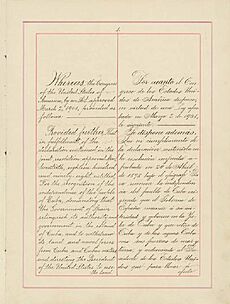Cuba–United States relations facts for kids
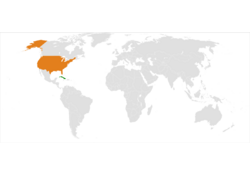 |
|
Cuba |
United States |
|---|---|
| Diplomatic Mission | |
| Embassy of Cuba, Washington, D.C. | Embassy of the United States, Havana |
| Envoy | |
| Cuban Ambassador to the United States Lianys Torres Rivera | American Ambassador to Cuba Benjamin G. Ziff (Chargé d'affaires) |
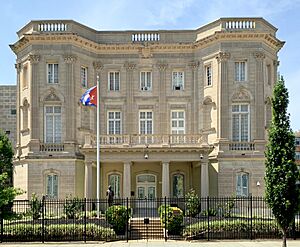

For many years, the relationship between Cuba and the United States has been complicated. These two countries are very close geographically. However, their governments have often disagreed.
Diplomatic relations were cut off in 1961 during the Cold War. But on July 20, 2015, Cuba and the United States decided to restore their official ties. Now, both countries have embassies in each other's capitals. The United States still has an economic embargo against Cuba. This means it is still difficult for U.S. companies to do business there.
Contents
- A Look at History
- Trade and Academic Relations
- Guantánamo Bay Naval Base
- Images for kids
A Look at History
Early Connections (Before 1800)


Connections between Cuba, a Spanish colony, and the North American mainland began in the 1700s. People traded goods, sometimes secretly, to avoid taxes. Cuba became a busy trading partner, known for its tobacco and sugar. Cuban merchants often visited North American ports, building lasting trade relationships.
In 1762, the British took over Havana for a short time. This opened up more trade with North and South American colonies. The American Revolution in 1776 created even more trade chances. Spain officially opened Cuban ports to North American trade in 1776. This made Cuba rely more and more on trade with the U.S.
The 1800s: U.S. Interest in Cuba
After 1818, trade with the U.S. grew stronger than with Spain. In 1820, Thomas Jefferson felt Cuba would be a great addition to the U.S. He even said the U.S. should try to take Cuba when possible. Secretary of State John Quincy Adams also believed Cuba would naturally join the U.S. if it separated from Spain.
In the 1840s, the U.S. wanted to get Cuba even more. President James K. Polk tried to buy Cuba from Spain for $100 million. Spain refused, saying they would rather see Cuba sink into the ocean. This idea also faced problems in the U.S. Congress.
In 1851, 40 Americans who joined a rebellion in Cuba were executed by Spanish authorities. This caused anger in the U.S. In 1854, a secret plan called the Ostend Manifesto suggested buying Cuba for $130 million. It even hinted at war if Spain refused. This plan became public and caused a scandal, especially because people against slavery opposed it.
From 1868 to 1878, Cubans fought Spain in the Ten Years' War. Many Americans supported the Cuban rebels. Groups in New York raised money and sent supplies to Cuba. President Ulysses S. Grant and his Secretary of State, Hamilton Fish, tried to stay neutral. They wanted stability and avoided officially recognizing Cuban independence.
By 1877, Americans bought most of Cuba's exports. More Americans also moved to the island. This helped connect Cuba's economy more with the U.S. and less with Spain.
Cuba's Independence and U.S. Influence (1890s)
As Cubans continued to fight for independence, U.S. Secretary of State James G. Blaine said in 1881 that Cuba was important to the U.S. He believed if Cuba stopped being Spanish, it must become American.
In 1897, after Cuban rebels had some success, U.S. President William McKinley offered to buy Cuba for $300 million. Spain said no. Then, the American battleship USS Maine exploded in Havana harbor. This led to the Spanish–American War. In Cuba, this war is known as "the U.S. intervention in Cuba's War of Independence."
On December 10, 1898, Spain and the U.S. signed the Treaty of Paris. Spain gave up all rights to Cuba. This treaty ended the Spanish Empire in the Americas. It also marked the start of the United States' growing power in the region. After the treaty, a U.S.-owned company quickly started selling Cuban land to Americans. The U.S. military governed Cuba until 1902, when Cuba officially became independent.
Relations from 1900 to 1959

The U.S. had said it would not control Cuba. However, it only removed its troops when Cuba agreed to the Platt Amendment in 1901. This amendment allowed the U.S. to step into Cuban affairs if needed. It also made Cuba lease land for U.S. naval bases, like Guantánamo Bay. The Platt Amendment shaped U.S.-Cuban relations for 33 years.
The U.S. intervened militarily in Cuba several times: from 1906–09, in 1912, and from 1917–22. For example, in 1912, U.S. forces were sent to stop protests by Afro-Cubans against discrimination. By 1926, U.S. companies owned 60% of Cuba's sugar industry. They bought 95% of Cuba's sugar crop.
President Calvin Coolidge visited Havana in 1928. This was the last time a sitting U.S. president visited Cuba for many years. In 1933, Cuban rebels overthrew the government of Gerardo Machado. U.S. Ambassador Sumner Welles asked for U.S. military help. President Franklin D. Roosevelt sent warships to Cuba and Key West.
When Ramón Grau became president, he canceled the Platt Amendment. The U.S. did not recognize his government.
The rise of General Fulgencio Batista in the 1930s led to close cooperation with the U.S. Batista was president for two terms (1940–44 and 1952–59). His second term began with a military takeover planned in Florida. President Harry S. Truman quickly recognized Batista's rule. The U.S. gave Cuba military and economic aid. During Batista's time, U.S. companies largely controlled Cuba's economy.
In July 1953, a conflict began between rebels led by Fidel Castro and Batista's government. The U.S. sold weapons to Batista's forces. However, in March 1958, the U.S. stopped selling rifles to Batista. This decision helped the rebels in the Cuban Revolution.
After the Cuban Revolution (1959 onwards)

After the 1959 Cuban Revolution, U.S. President Dwight D. Eisenhower recognized the new Cuban government. However, relations quickly worsened. The U.S. government worried about Cuba's land reforms. They also worried about Cuba taking over industries owned by U.S. citizens.
In April 1959, Fidel Castro visited the U.S. He met with Vice President Richard Nixon. Castro explained his plans for Cuba. Soon after, the U.S. began to put trade restrictions on the island. In September 1959, U.S. Ambassador Philip Bonsal told Castro about concerns for American businesses in Cuba.
As Cuba took over more private businesses, U.S. trade restrictions increased. The U.S. stopped buying Cuban sugar. It also refused to supply oil. This hurt Cuba's economy badly. Cuba then turned to the Soviet Union for oil and trade. In March 1960, a French ship exploded in Havana Harbor. Castro blamed the U.S., though he had no proof. That same month, President Eisenhower allowed the Central Intelligence Agency (CIA) to train Cuban refugees to overthrow Castro.
In April 1961, about 1,500 CIA-trained Cuban exiles invaded Cuba at the Bay of Pigs. The Cuban armed forces defeated them. President John F. Kennedy took full responsibility for the failed invasion. This event helped the Cuban government gain more support.
The U.S. then started new plans to weaken the Cuban government. These activities were called "Operation Mongoose". They included bombings, sabotage, and attempts to assassinate Cuban leaders. The Joint Chiefs of Staff even proposed attacks on U.S. targets to gain public support for military action against Cuba.
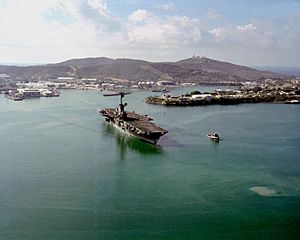
A U.S. Senate report later confirmed at least eight plots to kill Castro between 1960 and 1965. Tensions peaked in 1962 during the Cuban Missile Crisis. U.S. spy planes found Soviet missile sites being built in Cuba. This led to a very dangerous standoff between the U.S. and the Soviet Union.
Trade relations also got worse. In 1962, President Kennedy banned almost all trade with Cuba. A year later, U.S. citizens were not allowed to travel to Cuba or make financial deals there. The United States embargo against Cuba continued in different forms.
Despite tensions, some talks began after the Cuban Missile Crisis. President Kennedy and Fidel Castro even had indirect contact. Castro tried to improve relations with the new Johnson administration. He sent a message saying he hoped Cuba and the U.S. could respect and discuss their differences.
However, disagreements continued. These included the Guantánamo Bay dispute and Cuba welcoming American political activists. A major event was the capture of Che Guevara in 1967 by Bolivian forces, with U.S. help.
In the late 1960s and early 1970s, many planes were hijacked between Cuba and the U.S. This led to a need for cooperation. By 1974, U.S. officials started visiting Cuba. In 1977, during the Carter administration, both countries opened "interests sections" in each other's capitals. These were like small embassies.

From 1975 to 1976, the U.S. and Cuba supported opposite sides in the Angolan Civil War. Cuba sent troops to support the communist side. The U.S. gave money and weapons to the anti-communist side.
In 1977, Cuba and the U.S. signed a treaty about their sea border. In 1980, about 125,000 Cubans left for the U.S. in what was called the Mariel boatlift.
Starting in the 1970s, Cuban groups in the U.S. worked to challenge Castro's government. They focused on human rights issues at the United Nations. The Reagan administration took a tougher stance against Castro. In 1981, it tightened the embargo and banned U.S. citizens from spending money in Cuba.
In 1985, Radio y Televisión Martí began broadcasting news from the U.S. to Cuba. Since 1990, the U.S. has often criticized Cuba's human rights record at the UN.
After the Cold War
The Cold War ended in the early 1990s. This left Cuba without its main international supporter, the Soviet Union. Cuba then faced tough economic times, known as the Special Period. The long-standing U.S. embargo was made even stronger by laws in 1992 and 1996. These laws made it harder for foreign companies to trade with Cuba.
On February 24, 1996, Cuban military planes shot down two unarmed planes flown by a group called "Brothers to the Rescue". Three Cuban-Americans and one Cuban U.S. resident died. Cuba said the planes had entered its airspace.
In January 1999, U.S. President Bill Clinton eased travel rules to Cuba. He wanted to increase cultural exchanges. The Clinton administration allowed a baseball series between the Baltimore Orioles and the Cuba national baseball team. This was the first time a Major League Baseball team played in Cuba since 1959.
In September 2000, Castro and Clinton briefly met and shook hands at a UN summit. In November 2001, U.S. companies began selling food to Cuba for the first time since the embargo. In 2002, former U.S. President Jimmy Carter visited Cuba. He was the first former or sitting U.S. president to visit since 1928.
Tougher Embargo Rules
Relations got worse again after George W. Bush became president. He promised to tighten the embargo. In 2001, five Cuban agents were convicted in the U.S. for spying and other illegal acts. Tensions grew when John R. Bolton, a U.S. official, accused Cuba of having a biological weapons program. Many, including former President Carter, doubted this claim.

In January 2006, the U.S. Interests Section in Havana started showing messages on an electronic billboard. Cuba responded by putting up many black flags to block the messages. In October 2006, the U.S. announced a task force to go after Americans who broke the trade embargo. Penalties could be severe.
In November 2006, U.S. auditors said the USAID had not managed its program to promote democracy in Cuba well. They found that money was sometimes wasted or used for questionable items like chocolate.
After Fidel Castro resigned in 2008, the U.S. said it would keep the embargo.
Plans for "Democratic Change"
In 2003, the U.S. created the Commission for Assistance to a Free Cuba. Its goal was to help Cuba become a democracy. The commission announced stricter travel rules and efforts to stop illegal money transfers. Castro said Cuba was already changing, but towards socialism and communism.
In April 2006, the Bush administration appointed Caleb McCarry as "transition coordinator" for Cuba. He had a budget of $59 million to help Cuba shift to democracy after Castro's death. Cuban officials claimed this plan was a plot to assassinate Fidel Castro or invade Cuba.
The "Cuban Thaw"

Relations between Cuba and the U.S. started to get better in the late 2000s. Fidel Castro stepped down in 2008, and Barack Obama became U.S. president in 2009.
In April 2009, Obama began a less strict policy towards Cuba. He was open to talking with Cuba. He also eased some economic sanctions and travel rules for Cuban-Americans. For example, there were no longer time limits on how long Cuban-Americans could stay in Cuba. Rules for telecommunications were also loosened, making internet access easier.
Obama's efforts were met by Cuba's new leader, Raúl Castro. On July 27, 2012, Raúl Castro said Cuba was willing to talk with the U.S. about anything. On December 10, 2013, Obama and Raúl Castro shook hands at a memorial service for Nelson Mandela.
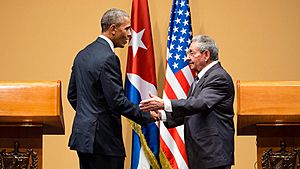
Starting in 2013, Cuban and U.S. officials held secret talks. Pope Francis helped arrange these meetings. On December 17, 2014, both countries announced a plan to normalize relations. They promised to reopen their embassies. As part of the deal, Cuba released American aid worker Alan Gross and a U.S. intelligence officer. The U.S. released the last three members of the Cuban Five.
On April 14, 2015, the Obama administration announced Cuba would be removed from the U.S. list of "State Sponsors of Terrorism". This officially happened on May 29, 2015. On July 1, 2015, President Obama announced that formal diplomatic relations would restart. Embassies opened in Washington and Havana on July 20, 2015.
Barack Obama visited Cuba for three days in March 2016. This was the first visit by a sitting American president in 88 years. In August 2016, the first direct commercial flight between the two countries since the early 1960s landed in Santa Clara.
Trump Administration
When Donald Trump became U.S. president in January 2017, the future of U.S.-Cuba relations was unclear. Trump had criticized the "Cuban Thaw" during his campaign.
On June 16, 2017, President Trump announced he was suspending what he called a "one-sided deal with Cuba." He said Obama's policy gave Cuba economic relief without getting anything in return. The Trump administration put new restrictions on travel and funding. However, diplomatic relations and embassies remained open.
On January 12, 2021, the U.S. State Department added Cuba back to its list of state sponsors of terrorism.
Health Issues of U.S. Diplomats
In August 2017, reports came out that American and Canadian diplomats in Havana had strange health problems. These included hearing loss, dizziness, and nausea. The cause of these symptoms, known as Havana syndrome, was not found. In September 2017, the U.S. ordered nonessential diplomats and their families to leave Cuba.
Biden Administration
Initially, the Biden administration kept the sanctions against Cuba that were put in place by the previous president. This was despite President Biden's campaign promise to lift restrictions.
In June 2021, the Biden administration voted against a United Nations resolution. This resolution called for an end to the U.S. economic embargo against Cuba. The resolution passed with 184 votes in favor. Only the U.S. and Israel voted against it.
In July 2021, protesters gathered outside the White House. They asked President Joe Biden to act on Cuba. The Biden administration then sanctioned some Cuban officials for human rights abuses. President Biden also said he would work to expand internet access on the island. He promised to support Cuban activists.
In May 2022, the Biden administration lifted some sanctions on Cuba. This included more flights to Cuba and restarting a family reunification program. However, on May 20, 2022, the Biden administration added Cuba to a list of countries that do not fully cooperate against terrorism.
In 2021, Cuba's government put its own embargo in place. This was due to U.S. economic pressures. It meant Cubans could not deposit U.S. dollars into their bank accounts. This led to shortages of medicine, food, and gasoline in Cuba. The Cuban government ended this embargo in March 2023.
Trade and Academic Relations
Trade Between Nations
Under a 2000 law, the U.S. can export food and medical products to Cuba. This requires special licenses.
In January 2011, the Obama administration eased some travel and other restrictions on Cuba. In February 2012, a U.S. Congress group met with Cuban leader Raúl Castro to discuss relations.
Travel and import rules were further relaxed in January 2015 as part of the Cuban Thaw.
Academic Connections
Academic relations between the two countries have changed over time. They were very limited after 1959. When diplomatic ties were cut in 1961, intellectual exchanges stopped. As U.S.-Soviet relations improved in the 1970s, more academic ties with Cuba became possible. Some American universities started Cuban studies programs. Cuban universities also began American studies programs.
The Carter administration eased travel rules in the late 1970s. But the Reagan administration put them back in place after 1981. As the Cold War ended, restrictions were relaxed again. In 1992, a law called "Track 2" helped intellectual cooperation. In 1999, President Bill Clinton allowed licenses for study abroad programs in Cuba. However, in 2001, President George W. Bush reversed this. He restricted travel again. Under Barack Obama, restrictions were cut back, but then put back in place by President Donald Trump.

The U.S. still operates a naval base at Guantánamo Bay. This is under a lease agreement from 1903. The U.S. sends a check to Cuba each year for the lease. However, since the Cuban Revolution, Cuba has only cashed one payment. The Cuban government believes the treaty is illegal. They say it was forced upon them.
Leasing land like Guantánamo Bay was a requirement of the Platt Amendment. These were conditions for the U.S. to remove its troops from Cuba after the Spanish–American War.
Images for kids
-
Douglas A-4 Skyhawks from the USS Essex flying over combat areas during the Bay of Pigs Invasion in 1961.



